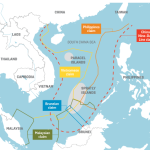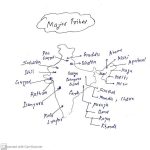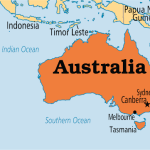India is a beautiful place to live because it has a lot of rivers running through it. Most of the rivers in the country run east, which means they end up in the Bay of Bengal. However, there are a few rivers that go against the grain and flow west. These rivers end up in the Arabian Sea.
Table of Contents
- 1 Rivers of Peninsular India that flow west
- 2 Estuary
- 3 Narmada River
- 4 Rivers that flow into the Narmada
- 5 River Tawa
- 6 River Tapti
- 7 Rivers that flow into the Tapti
- 8 Projects on the Tapti River
- 9 Industry in the Tapti Basin
- 10 Sabarmati River
- 11 Industry in Sabarmati Basin
- 12 River Mahi
- 13 Tributaries of Mahi:
- 14 Luni River
- 15 West flowing Rivers of the Sahyadris (Western Ghats)
- 16 Ghaggar River – Drainage on Land
- 17 Mhadei river
- 18 Usability of Rivers
Rivers of Peninsular India that flow west
• Peninsular India’s rivers that flow west are smaller and less numerous than those that run east.
• The Narmada and the Tapi are the two largest rivers that run west.
• Other rivers: Shetrunji River, Bhadra, Dhandhar, Sabarmati, Mahi, Vaitarana, Kalinadi, Bedti river, Sharvati, Mandovi, Juari, Bharatpuzha, Periyar, Pamba river, etc.
• These rivers are unusual because they don’t form valleys. Instead, they run through faults (linear rift, rift valley, or trough) that were made when the Himalayas were formed and the northern peninsula bent.
• These flaws run in the same direction as the Vindhyas and Satpuras.
• Other rivers in Peninsular India that run west are the Sabarmati, Mahi, and Luni.
• Hundreds of small streams start in the Western Ghats and run quickly west until they reach the Arabian Sea.
• It’s interesting to note that Peninsular rivers that flow into the Arabian Sea don’t make deltas, but only estuaries.
• This is because rivers that run west, especially the Narmada and the Tapi, flow through hard rocks and don’t carry a lot of silt.
• Also, the streams that feed into these rivers are very small, so they don’t add any silt.
• Because of this, these rivers can’t make branches or a delta before they reach the sea.
• There are some rivers in Rajasthan that don’t flow into the sea. They flow into salt lakes, where they get stuck in the sand and can’t reach the sea. In addition to these, there are the Desert Rivers, which run for a long way and then disappear into the desert. These include Luni, Machhu, Rupen, Saraswati, Banas, and Ghaggar, among others.

Estuary
• An estuary is a body of water along the coast that is partially surrounded by land. It is where fresh water from rivers and streams mixes with salt water from the ocean. (The primary production of estuaries is very high. Most estuaries are good places for birds to live.
• Estuaries and the land around them are places where the land meets the sea and where fresh water meets salt water.
• They are affected by the tides, but buffer islands and peninsulas protect them from the full force of ocean waves, winds, and storms.
• Estuarine settings are some of the most productive on Earth. Each year, they make more organic matter than areas of forest, grassland, or farmland that are the same size.
• The protected, tidal waters of estuaries are home to unique groups of plants and animals that have evolved to live near the sea.
• Estuaries have a lot of business value, and their resources help tourism, fishing, and leisure activities make money.
• The protected coastal waters of estuaries also support important public facilities, like harbours and ports that are important for shipping and transportation.
• Estuaries also do other important things. When water from uplands flows into estuaries, it brings sediments, nutrients, and other pollution with it. As water moves through wetland areas like swamps and salt marshes, it filters out a lot of the sediments and pollutants.
• Saltmarsh grasses and other plants that grow in estuaries also help stop erosion and keep shorelines stable.
Narmada River
• Narmada is the largest river in peninsular India that flows west to east.
• The Narmada River runs west through a rift valley between the Vindhyan Range and the Satpura Range.
• It starts about 1057 m above sea level in the Maikala hills near Amarkantak, Madhya Pradesh.
• Narmada basin has an area of about 1 million square kilometres and is made up of the states of Madhya Pradesh, Gujarat, Maharashtra, and Chhattisgarh.
• The north is bordered by the Vindhyas, the east by the Maikala range, the south by the Satpuras, and the west by the Arabian Sea.
• It is 1,310 km long from where it starts in Amarkantak to where it ends in the Gulf of Khambhat.
• The upper part of the basin has hills, and the lower and middle parts are wide, fertile places that are good for farming.
• There is only one big city in the basin, and it is called Jabalpur.
• The river drops down near Jabalpur, where it forms the Dhuan Dhar (Cloud of Mist) Falls, which are 15 metres high and drop into a gorge.
• The gorge is often called the Marble Rocks because it is made of marble.
• At Mandhar and Dardi, it forms two 12 m waterfalls. Near Maheshwar, the river flows down from another small fall, the Sahasradhara Falls, which is 8 m high.
• The Narmada waterway has a number of islands, with Aliabet being the biggest.
• You can sail on the Narmada up to 112 km from where it starts.
Rivers that flow into the Narmada
• The Barna, Hiran River, Tendoni River, Choral River, Kolar River, Man River, Uri River, Hatni River, and Orsang River flow into the river from the right bank.
• Left side tributaries: Burhner River, Banjar River, Sher River, Shakkar River, Dudhi River, Tawa River, Ganjal River, Chhota Tawa River, Kaveri River, Kundi River, Goi River, and Karjan River
• Indira Sagar, Sardar Sarovar, Omkareshwar, Bargi, and Maheshwar are the largest hydroelectric projects in the area.

River Tawa
• The river starts in the Satpura Range of Betul in the Indian state of MP.
• This is the longest river that flows into the River Narmada.
River Tapti
• The Tapti, which is also called the Tapi, is the second biggest river in Peninsular India that flows west. It is called the “twin” or “handmaid” of the Narmada.
• It starts at a height of 752 m near the Multai reserve forest in Madhya Pradesh.
• It flows for about 724 kilometres before it empties into the Arabian Sea through the Gulf of Cambay.
• The Tapti River and its tributaries run through the plains of Vidharbha, Khandesh, and Gujarat. They also flow through large parts of the state of Maharashtra and a small part of the states of Madhya Pradesh and Gujarat.
• The valley covers an area of about 65,000 square kilometres in the states of Madhya Pradesh, Maharashtra, and Gujarat.
• The basin is on the Deccan plains. To the north, the Satpura range, to the east, the Mahadev hills, to the south, the Ajanta Range and the Satmala hills, and to the west, the Arabian Sea.
• The basin’s hills are well-forested, and the plains are wide, fertile places that can be used for farming.
• The basin has two clearly defined physical areas: the hills and the plains. The Satpura, Satmalas, Mahadeo, Ajanta, and Gawilgarh hills are in the hills.
• The plain includes the Khandesh areas, which are mostly good for farming. Khandesh is a region in central India that makes up the northwestern part of Maharashtra state.
Rivers that flow into the Tapti
• The Suki, the Gomai, the Arunavati, and the Aner are all on the right bank.
• On the left bank are the Vaghur, Amravati, Buray, Panjhra, Bori, Girna, Purna, Mona, and Sipna rivers.
Projects on the Tapti River
• Upper Tapi Dam Hathnur Project (Maharashtra)
• Kakrapar weir and Ukai Dam of Ukai Project (Gujarat)
• The Girna Dam and Dahigam Weir of Girna Project (Maharashtra)
Industry in the Tapti Basin
• The textile factories in Surat and the paper and news print plant in Nepanagar are two important industries in the basin.

Sabarmati River
• The Sabarmati is the name for both the Sabar and the Hathmati rivers together.
• The Sabarmati valley is made up of 21,674 square kilometres of land in the states of Rajasthan and Gujarat.
• The Aravalli hills to the north and northeast, the Rann of Kutch to the west, and the Gulf of Khambhat to the south form the basin’s borders.
• The basin is generally in the shape of a triangle, with the Sabarmati River at the bottom and the Vatrak River’s source at the top.
• Sabarmati starts in the Aravalli hills, which are 762 m high and near the town of Tepur in Rajasthan’s Udaipur district.
• The river is 371 km long from where it starts to where it flows into the Arabian Sea.
• Most of the basin is used for farming, which takes up 74.68% of the total land area.
• The amount of rain changes from just a few millimetres in Saurashtra to more than a thousand millimetres in the south.
• The Wakal, the Hathmati, and the Vatrak flow into the river from the left bank.
• On the right bank, the Sei.
• Major projects finished during the plan time include the Sabarmati reservoir (Dharoi), the Hathmati reservoir, and the Meshwo reservoir project.

Industry in Sabarmati Basin
• The most important cities in the area are Gandhinagar and Ahmedabad.
• The city of Ahmedabad is an industrial hub on the banks of the Sabarmati River.
• Textiles, leather and leather goods, plastic, rubber goods, paper, newsprint, cars, machine tools, drugs and medicines, etc. are all important industries.
• Water pollution could happen in the city of Ahmedabad, which has a lot of factories.
________________________________________
River Mahi
• The Mahi valley is made up of 34,842 square kilometres of land in the states of Madhya Pradesh, Rajasthan, and Gujarat.
• It is surrounded by the Aravalli hills on the north and north-west, the Malwa Plateau on the east, the Vindhyas on the south, and the Gulf of Khambhat on the west.
• Mahi is one of India’s major rivers that move west across state lines.
• It starts on the 500-meter-high northern slopes of the Vindhyas in the Dhar area of Madhya Pradesh.
• Mahi is 583 km long as a whole.
• The Gulf of Khambhat is where it empties into the Arabian Sea.
• Most of the basin is made up of farmland, which takes up 63.63% of the total area.
• Hydro Power stations are found – Mahi Bajaj Sagar dam, Kadana Dam, and Wanakbori dam (Weir).
• The only important city in the area is Vadodara. In the area, there aren’t many businesses.
• Cotton textiles, paper, newsprint, drugs, and pharmaceuticals are some of the businesses. Most of these businesses are in the Ratlam area.

Tributaries of Mahi:
• Som
This is a river that flows into Mahi from the right bank. The Som river starts near Som on the eastern slopes of the Aravalli hills in the Udaipur district of Rajasthan. It is 600 m above mean sea level and runs east to join the main river Mahi on the right bank 6.3 km upstream of Paderdibadi site in the Dungarpur district of Rajasthan. It is about 155 km long as a whole. The area that Som drains is 8707 sq. km. Gomti and Jakham are the main rivers that flow into Som from the right bank.
• Anas
This stream flows into Mahi from the left bank. The Anas River starts near Kalmora on the northern slopes of the Vindhyas in the Jhabua district of Madhya Pradesh. It is 450 m above mean sea level and runs north to west until it meets the main river Mahi in the Dungarpur district of Rajasthan. It is about 156 km long and drains a total area of 5604 sq. km. km.
• Panam
This stream flows into Mahi from the left bank. The Panam river starts near Bhadra on the northern slopes of the Vindhyas near the Jhabua district in Madhya Pradesh at an elevation of about 300 m above m.s.l. It flows north to west and meets the main river on the left bank in the Panchmahal district of Gujarat. It is about 127 km long and drains an area of about 2470 sq. km. km.
________________________________________
Luni River
• The Luni, also known as the Salt River (in Sanskrit, Lonari or Lavanavari), got its name because its water is salty below Balotra.
• Luni is the only important river valley in Western Rajasthan, which is mostly a dry area.
• The Luni starts on the western slopes of the Aravalli ranges, 772 m above sea level, near Ajmer. It runs southwest for 511 km in Rajasthan, until it reaches the Rann of Kachchh, where it gets lost in the marsh.
• Most of the rivers that flow into it come from the steep northwest side of the Aravalli hills and join it on the left. It gets all of its water from Rajasthan.
• This river is different because it tends to get wider instead of deeper. This is because the sides are made of soil, which is easily washed away, but the bed is made of sand. Since floods come and go so quickly, they don’t have time to clean the bed.

West flowing Rivers of the Sahyadris (Western Ghats)
• About 600 small rivers start in the Western Ghats and run west until they reach the Arabian Sea.
• The south-west monsoons bring a lot of rain to the western slopes of the Western Ghats, which is why they can feed so many streams.
• Even though only about 3% of the land area flows quickly down the steep hill, and some of them make waterfalls, there are still a lot of them.
• The most well-known waterfall in India is the Jog or Gersoppa Falls (289 m), which is made by the Sharavati river.
Sharavati is a river that starts in the state of Karnataka and goes through it the whole way.
Ghaggar River – Drainage on Land
• Some rivers in India can’t get to the sea, so they drain the land instead.
• There is inland flow in a lot of the Rajasthan desert and some of the Aksai Chin in Ladakh.
• The most important river for interior drainage is the Ghaggar. It is a seasonal stream that flows down from the lower Himalayas and separates Haryana and Punjab.
• After going 465 km, it gets lost in the dry sands of Rajasthan, close to Hanumangarh.
• This river used to flow into the Indus, and you can still find the dry bed of the old route.
• The Tangri, the Markanda, the Saraswati, and the Chaitanya are the major rivers that flow into it.
• During the rainy season, when its bed gets as wide as 10 km, it holds a lot more water.
• Most of the streams that flow down the western slopes of the Aravalli Range dry up as soon as they reach the sandy, dry lands west of this range.
Mhadei river
• The west-flowing Mahadayi or Mhadei river starts in the Bhimgad Wildlife Sanctuary in the Belagavi district of Karnataka. This area is part of the Western Ghats.
• It is mostly a river that gets its water from rain. In Goa, it is called Mandovi.
• It joins with a few other rivers to make the Mandovi, which is one of two major rivers that flow through Goa. The other is the Zuari.
• The river flows through Karnataka for 35 km and through Goa for 82 km before it flows into the Arabian Sea.
• Kalasa-Banduri Nala project
The Government of Karnataka is working on this project to improve the water supply in the districts of Belagavi, Dharwad, and Gadag. It includes building across the Kalasa and Banduri rivers, which flow into the Mahadayi, to send 7.56 TMC of water to the Malaprabha.
In 1989, the Kalasa-Banduri project was planned, but Goa objected to it.
________________________________________

Usability of Rivers
• A source of fresh water, a way to grow crops, make hydroelectric power, get around, etc.
• There are places where water power could be used on a big scale in the Himalayas, Vindhyas, Satpuras, Aravalis, Maikala, Chhotanagpur plateau, Meghalaya plateau, Purvachal, Western Ghats, and Eastern Ghats.
• Sixty percent of the total river flow is concentrated in the rivers of the Himalayas, 16 percent in the rivers of Central India (like the Narmada, the Tapi, the Mahanadi, etc.), and the rest in the rivers of the Deccan plains.
• Some of the most important and useful waterways in the country are the Ganga and the Brahmaputra in the north and northeast, the Mahanadi in Odisha, the Godavari and the Krishna in Andhra Pradesh and Telangana, the Narmada and the Tapi in Gujarat, and the lakes and tidal creeks in the coastal states.
• In the past, they were very important, but when trains and roads came along, they lost a lot of their value.
• The flow of many rivers has slowed down because farmers have taken out a lot of water for farming.
• The Ganga, the Brahmaputra, and the Mahanadi are the most important rivers that can be sailed on. The only place you can go on the Godavari, the Krishna, the Narmada, and the Tapi is near where they meet the sea.










![UPSC CSE Topper Mains Answer [Part 1] images-2023-06-17T191749.185](https://iasbio.com/wp-content/uploads/2023/06/images-2023-06-17T191749.185-150x150.jpeg)






